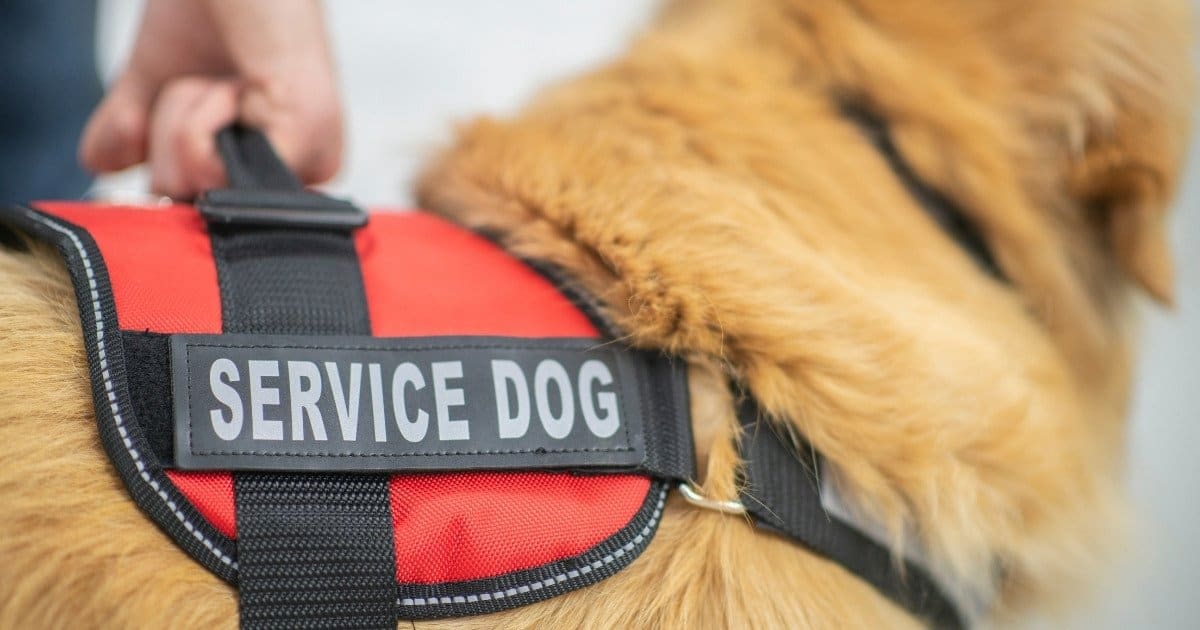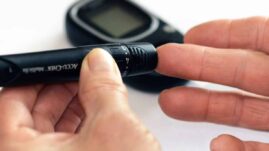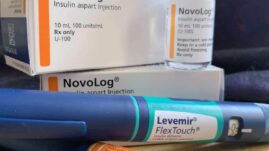If you live with diabetes and struggle with a condition known as hypo-unawareness, that means that you can’t detect your low blood sugars until they are in a dangerous place.
While continuous glucose monitors (CGMs) and hybrid closed-loop insulin pump systems have helped alleviate some of the dangers for people living with diabetes, sometimes having a diabetes alert dog can be the safest bet to protect you from dangerous lows, potential seizures, and even fatal consequences.
But how do you get a diabetes alert dog? Are they covered by health insurance? Are they expensive, and are they appropriate for everyone?
This article will outline everything you need to know about getting a diabetes alert dog of your own.

Table of Contents
- What is a diabetes alert dog?
- How does the dog alert its owner or bring help?
- Are diabetes alert dogs effective?
- Who qualifies for a diabetes alert dog?
- Diabetes alert dogs aren’t just pets
- Are diabetes alert dogs expensive?
- How to get a diabetes alert dog
- Success with diabetes alert dogs
- Frequently asked questions
- Conclusions
What is a diabetes alert dog?
Diabetes alert dogs (also called diabetes service dogs or DADs) are service or assistance dogs that are specially trained to detect high and low blood sugars in individuals with diabetes.
They can detect high and low blood sugars before they reach dangerous levels (which can be especially helpful in preventing dangerously low blood sugar levels and seizures).
Diabetes alert dogs can detect the chemical changes in their owner’s body when their blood sugars are rapidly rising or falling; the scent these chemical changes release is undetectable to humans.
Under the Americans with Disabilities Act, when diabetes alert dogs are fully trained and certified, they can accompany their owners almost everywhere they go, just like any other service animal.
How does the dog alert its owner or bring help?
Diabetes alert dogs are specially trained to give their owner a specific signal if the owner is going dangerously high or low. Some signals may include:
- Tapping the owner repeatedly with their nose
- Pawing at the owner’s lap
- Jumping up into the owner’s lap
- Barking or whining
- Alerting other family members by running to them to bring help
- Bringing over needed objects, such as a diabetes supply bag
- Retrieving a phone for the owner
- Some dogs may even be trained to dial 911 on a special device to get help
Are diabetes alert dogs effective?
A dog’s sense of smell is up to 100,000 times more sensitive than a human’s, making them excellent service animals for all types of health needs.
Dogs have more than 225 million scent receptors in their noses (humans only have 5 million), and 1/8 of the brain is devoted solely to the olfactory bulb, making dogs highly accurate when it comes to smelling.
With the proper positive reinforcement training that these dogs receive for detecting the “correct” scent of a low or high blood sugars, most diabetes alert dogs have a 95% success rate of deciphering whether their owners are experiencing a hypoglycemic or hyperglycemic episode, before they become dangerous.
Having an animal of any kind has been proven to help alleviate stress, anxiety, and depression, which is also a great thing if you live with a chronic illness, including diabetes!
Who qualifies for a diabetes alert dog?
Diabetes alert dogs especially help people with hypo-unawareness, which affects nearly 40% of people with type 1 diabetes.
Diabetes alert dogs are also helpful for people who are sensitive to insulin or prone to extremely low blood sugars.
Other qualities where it might make sense to get a diabetes alert dog include:
- Individuals who have frequent low blood sugars
- Individuals who suffer from low-blood-sugar-induced seizures
- Individuals who experience frequent low blood sugars at night
- An individual with diabetes who lives alone
- Individuals with co-morbidities or multiple diagnoses
If you’re struggling with frequent high and low blood sugars, you may want a diabetes alert dog.
However, many endocrinologists will recommend that their patients try a continuous glucose monitor (CGM) with alerts and alarms first, before recommending a diabetes alert dog.
If you’re applying for a diabetes alert dog through a private agency, they may have their own eligibility criteria that you must meet in order to receive one.
Usually, however, a diagnosis of diabetes and suffering from hypo-unawareness will be enough to qualify.
Some agencies, however, prefer owners to be at least 12 years old, to make sure they can properly care for the dogs as their own.
Diabetes alert dogs aren’t just pets
You may think that you want a diabetes alert dog because you have diabetes and you love dogs. If this is the case, it’s best to get a regular pet, as diabetes alert dogs are so much more than a family pet.
They are working 24 hours a day, 7 days a week, 365 days a year to keep their owner safe from high and low blood sugars, and they also require a lot of work from their owners, too.
People considering getting a diabetes alert dog must be cognizant of the time, energy, and money that having one will require.
If you are struggling with your blood sugars and have talked with your doctor about getting a diabetes alert dog, starting the process of getting one as soon as possible will be helpful, as wait times to receive your dog can be anywhere from a few months to several years.
Are diabetes alert dogs expensive?
Unfortunately, in the United States, nearly no health insurance will cover the cost of a diabetes alert dog, and these dogs can be extremely expensive.
No state Medicaid plan nor Medicare will cover the cost of a service animal, which can range from $8,000 to $25,000 (plus ongoing upkeep of your new dog, including food, veterinary checkups, licensing and registration, grooming, toys, and more).
Service animals are trained from a young age, and so upkeep and ongoing costs for them can last for a decade or more.
More health insurance plans than ever are denying service animal claims, due to the rise in popularity and efficacy of continuous glucose monitoring systems, and their relative affordability compared to a service dog.
However, some non-profit organizations in the United States will provide a service animal for free if you qualify (and pay for their training).
Many organizations will offer a payment plan, so you don’t have to pay the full price up front.
Most organizations also offer a lifetime guarantee of their dogs; if they stop detecting high and low blood sugars, they will pair you with a new dog, or refund you.
It is estimated that up to 70% of people who need service dogs in the United States cannot afford them.
Talk with your family if you’re considering getting a diabetes alert dog. Make a budget and a plan, and see if it’s the right financial move for you and your family.
How to get a diabetes alert dog
Once you’ve made a budget and a plan, and have spoken with your doctor and family about getting a diabetes alert dog, the next question to answer is: where can I get one?
Almost all service dog agencies have an online presence (there are both for-profit and nonprofit agencies, and that will largely determine the cost).
Doing a bit of online research can help you get a sense of their teaching methods and process for pairing alert dogs with applicants.
You will want to get a dog that will match your lifestyle and preferences. Agencies will work hard to find the perfect fit for you: your activity level, age, life goals, and lifestyle will all determine not only what breed you’ll get, but what gender, age, and personality they will match you with.
You can also contact Assistance Dogs International for information about agencies that breed service dogs in your state.
Additionally, your endocrinologist, local diabetes non-profit, or even a local diabetes support group may also have recommendations for potential diabetes alert dog agencies near you.
Success with diabetes alert dogs
People who have diabetes alert dogs report higher rates of life satisfaction, decreased depression and anxiety around managing their diabetes, and increased confidence in their control.
When people have a service animal like a diabetes alert dog, they also may decrease the number of times they go dangerously low and experience seizures, or dangerously high and fall into diabetic ketoacidosis (DKA).
Their emergency room visits and hospital admission rates go down, and they may suffer from fewer diabetes complications. Another added benefit is they always have a companion by their side.
However, diabetes alert dogs can be expensive and time-consuming, and losing a beloved pet at the end of their life can be devastating to their owner.
Additionally, having a diabetes alert dog doesn’t do away with the need to test your blood sugar regularly, or otherwise save money on diabetes supplies.
Frequently asked questions
How long does it take to get a diabetes alert dog?
Due to long wait times, high demand, limited supply, and length of special training, it can take anywhere from 6 months to a few years to get a diabetes alert dog.
If you’re interested, speak with your doctor sooner rather than later, and start an application process soon, as the minimum wait is usually 6 months.
What breeds can become diabetes alert dogs?
There are no restrictions on the breeds that can be trained to become diabetes alert dogs, but a few breeds are especially well equipped due to their kind and gentle nature, extreme intelligence, loyalty, and ability to be trained.
The most popular types of dogs that become diabetes alert dogs are golden retrievers, labrador retrievers, Australian shepherds, large poodles, and large mixed dogs (hunting and sporting breeds).
Can children get diabetes alert dogs?
Yes! It is absolutely possible to have your child get a diabetes alert dog, especially if they suffer from frequent and dangerous low blood sugars and/or experience hypo-unawareness.
The ultimate decision, however, comes down to the agency that you choose to work with (some require that a recipient be at least 12 years old). This is to ensure that the owner can properly care for their dog, as all dogs require love, attention, food, water, shelter, exercise, and regular upkeep for their entire lives.
Can you train the dog yourself?
According to ADA regulations, all disabled people have the right to train the dog themselves and are not required to use a professional service dog training program.
However, If you’re struggling with hypo-unawareness and are in need of a diabetes alert dog, it is NOT recommended that you try to train a dog on your own.
It takes more than a year of intensive training to fully train a diabetes alert dog and not all dogs pass the final exam, even when professionally trained.
Also, the dog is not legally considered a service animal until fully trained, so you will not be able to bring it with you everywhere while it’s in training.
It is best to go with a professionally trained diabetes alert dog. This is the safest option that will ensure you the best care.
Does the dog have to be certified as a service animal?
No. Covered entities may not require documentation, such as proof that the animal has been certified, trained, or licensed as a service animal, as a condition for entry.
However, it is legal to require you to show proof that you need a service animal to, for example, board a plane with your dog.
Are there places where you cannot bring a diabetes alert dog?
Under the Americans with Disabilities Act, diabetes alert dogs (DADs) are recognized as official service animals and are allowed to accompany their owners everywhere they go.
This includes restaurants, airports, airplanes, school and work settings, hair salons, stores, museums, hotels, and even hospitals. Service animals are allowed to go anywhere where there are “public accommodations”.
The only exception is when the workplace is deemed too dangerous for the service animal (for example restaurant kitchens or construction sites) or if the dog poses a health hazard (for example ultra-clean pharmaceutical production facilities).
If someone is giving you trouble for bringing your diabetes alert dog somewhere, they are violating the protections provided by the federal Americans with Disabilities Act and may be exposing themselves to legal liability.
Conclusions
Getting a diabetes alert dog can be an excellent way to better manage your blood sugar levels, especially if you suffer from hypo-unawareness, live alone, struggle with diabetic seizures from low blood sugars, or juggle multiple chronic conditions.
Work with your doctor first to determine if using a continuous glucose monitor (CGM) system may be more appropriate than getting a service animal, as they can be expensive, are not covered by most health insurance, and require a lot of time, energy, money, and upkeep for their entire lives.
However, diabetes alert dogs can be accurate in detecting high and low blood sugar levels up to 95% of the time.
They can help prevent dangerous high and low blood sugars, unnecessary hospitalizations, and can (and have!) saved lives.
Plus, having a constant companion can reduce stress, anxiety, and depression, which are more prevalent in people with diabetes.
Talk with your family and health care provider to determine if getting a diabetes alert dog is the right thing for you, your lifestyle, your budget, and your diabetes management.




Terry Gersdorf
How can a Veteran get a DAD I have frequent episodes of Nocturnal Hypoglycemia and live alone.
Christel Oerum
Try contacting Assistance Dogs International. Scroll down to the “How to get a diabetes alert dog” section and follow the link
Sandra Jefferson
Where can I get a application at
Nellie Coleman
I wish to get a Diabetes alert dog. How can I get an application. Can you guide me through the process? Thank you
Christel Oerum
If you scroll down the article you’ll see a high-level guide on how to get started
Terry Gersdorf
Can you provide a link here on how and where to apply for a D.A.D.
Thanks
Christel Oerum
Try contacting Assistance Dogs International. Scroll down to the “How to get a diabetes alert dog” section and follow the link
Angela
Please help me find a dad dog I’m a type one brittle diabetic w many bouts of DKA and comas and seizures my doctor wants me to get a diabetic alerts dog but I’m not able to find one I’m In Connecticut. Thank you
Christel Oerum
We don’t have any more resources than the ones mentioned in the article
Darcy Karouzos
I got a mini golden doodle in 2000 and he started alerting me when I was low, before my dexcom alerted me! I never trained him! Plus he tells me when I am high with tapping me with his nose. He is AMAZING!
Just get a golden retriever or golden doodle if you have allergies.